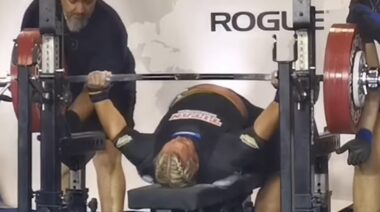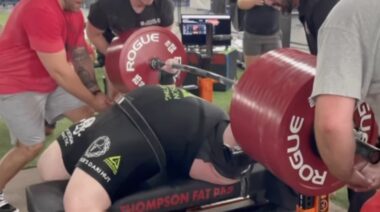It’s beach season, and for those of us in the fitness world, that means it’s bench season. Whether it’s part of a regimented plan or just a sudden urge to pump up the guns before heading out for the night, a sudden interest in the bench press tends to sweep through the gym world as the days get hotter.
I’m a fan of anything that gets people under the bar, but let’s take a moment to cover a subject that often doesn’t get the airtime it should: safety. Specifically, bench safety. Many people underestimate the barbell bench press. All you have to do is bring the bar down and push it back up again, right? Not quite.
In the bench press, you have a heavy barbell passing over some pretty important stuff that doesn’t like being hit by hundreds of pounds of iron. You know: the throat, face, and sternum. Gym deaths are exceptionally rare, especially if you don’t count pre-existing conditions and freak medical incidents, but when they happen, it’s usually during the bench. Rather than become a statistic or a headline, let’s take a minute to ensure you get swole safely.
If a bench press goes bad, there’s some pretty important stuff in the way of the bar. [Photo by SSGT Ricky A. Bloom]
When Good Benches Go Bad
There are generally a few ways that a bench can go sideways:
- The Slow Ride: The most common and most manageable, this fail happens when the lifter simply runs out of steam and the bar starts to come down, under control, onto the lifter’s chest. A spotter can pull it up as soon as it starts going down, and if there is no spotter, the lifter can tilt the bar to one side, dumping the weight and getting out from under the bar. It’s embarrassing, sure, but if the equipment is set up correctly, this shouldn’t cause more than a little noise and a bruised ego.
- The Half-Press: This travesty happens when the lifter starts the press, can’t quite make it, and desperately tries to shove the weight up and back towards the pins. It’s an instinctive reaction to push the bar to safety, but when the bar gets above or behind the shoulders, the lifter is put in a terrible position to actually move the weight. The bar tends to come halfway up…then all the way down.
- The Bad Day: The lifter experiences a tear, pull, or other injury that prevents them from pressing the weight up to finish.
How to Prevent Bench Press Tragedies
With these in mind, there are a few important guidelines for how to safely execute the king of bro-lifts:
- Bench with a friend. If at all possible, never bench alone. You should have a spotter for all working weights. If you’re at a commercial gym, don’t be afraid to ask for a spot and give one freely when asked. Taking an additional 30 seconds of rest will not throw off your cycle. Offering to spot and doing it well are part of what makes the iron community friendly, safe, and positive.
- Be an attentive spotter. Any time the bar is not in the rack, the spotter only has one purpose: to watch the lifter. Not the cutie in the corner. Not the football game on the TV. The lifter.
- Your spotter does not read minds. If you’re the lifter, talk to the spotter about what you’re doing before you start. How many reps? Do you want help with some forced reps or do you want the spotter to touch it only to save a failed lift? A few words before the lift can save you a lot of frustration and save your spotter a big surprise.
- Pick a smart weight. 99% of the time, you have no business going down with a weight you might not get back up. Accidents happen, but maximal efforts should be planned for in your training, and you should plan on having spotters and the right equipment to do these safely. If you decide last minute you’re going to try to impress the cute babe in the corner with a ‘legendary’-effort 2-plate bench… good luck.
- Don’t depend on the spotter. In the event you have to use your spotter, never give up on the weight. Most benches put the spotter in a bad position to provide support, and even strong lifters will struggle to help you if your ego loads up 100 pounds more than you can handle. They are there to assist, not to lift the weight for you. If you overestimate by 5 or 10 pounds and keep fighting it, the smallest lifter in the gym will be able to save you, but if you give in mentally and leave it all to the spotter, you deserve whatever you get. Don’t be that guy who tells the spotter: “It’s all you, bro.”
- Fail gracefully. If you can tell you’re running out of gas or something goes sideways in your shoulders, don’t panic. Default to the slow ride if you can and get your spotter to help or bring the bar slowly down to your chest.
- Lock the arms any time the bar is moving over the face. Never take a ‘soft spot’ (receiving the bar with bent arms), and never attempt to rack the bar with bent arms.
- Use a safe grip. Some lifters prefer a suicide grip (thumb on the same side as the fingers, not wrapped around the bar). I don’t recommend it. One careless lift, sweaty hand, or bad day, and there is nothing but air between the bar and some very important infrastructure.
The Equipment Setup
As with all lifts, half of safety is having the right equipment and using it correctly. With this in place, even a catastrophic fail can be salvaged, allowing you to walk out of the gym to lift another day.
If you must bench alone (but please, try to avoid that), either at your house or in an empty gym, do not put clips on your bar. This way, you can dump the bar to one side after it’s failed on your chest. I know some gyms require clips. In that case, it becomes doubly imperative that you have a spotter. I can’t repeat this enough.
If you’re going to get a bench for home use or have a choice at the gym, use one in a power rack or squat rack that will allow you to place safety bars. Place the bar at a height where the bar will only touch your chest but will stop the bar before it goes all the way down to your neck. It won’t eliminate the possibility of you getting hurt by a ‘bad day’ bench, but the safety bars leave you with a dramatically better chance of walking away from it in one piece.
Remember, “Smith” does not equal “safe.” Most railed-barbell machines allow you to roll the wrists forward and freeze the bar mid-rep, but that won’t necessarily help. Most bench efforts get stuck at the very bottom, and unless you have the strength and coordination to push the bar up to the next notch lock it in place after a failed rep, it can still go wrong.
Nobody Gets a Tan in the Hospital
I don’t say any of this is to discourage you from lifting. Enjoy the sun, the beach, and the bench. Just enjoy it smart so you can come out stronger, smarter, and tanner than you were before.
Before you even lay down on the bench, are you sure you’re ready?






